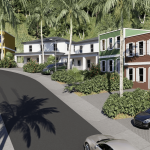While the pipeline for multifamily housing projects has slowed severely since the end of 2023 in Austin, a local developer has announced something of a rarity: a new 110-unit project aimed primarily at workforce and middle-income residents.
Earlier this week, Notional Development Partners, which is based in Austin, announced the close of funding for its 600 Cumberland project that will be located just off South First Street to the south of Oltorf Street. Half of the units in the eight-story, half-acre project will be priced for affordability to those earning from 50 percent to 80 percent of the area’s median family income.
Guidelines from the Austin Housing Finance Corporation would put the maximum rent for those units from $1,102 to $1,712 for an efficiency apartment, $1,181 to $1,956 for a one-bedroom unit and $1,417 to $2,201 for a two-bedroom unit. To subsidize the affordable units, the developers are seeking a property tax exemption for the project, which was rezoned for greater density as part of City Council’s recent adoption of land use changes to encourage equitable transit-oriented development.
The project is slated to break ground next spring, with opening slated for 2027. The ground floor space on the property will include just over 8,000 square feet of commercial space, with a restaurant and retail use planned for the two available units.
Perkins Eastman is the architect. KFM Engineering & Design is the civil engineer. Wylie Engineering is handling mechanical, electrical and plumbing systems. Dunaway is the structural engineer. TBG has been selected as the landscape architect.
The project has received site plan approval, with work continuing to secure architecture and building permits in time to meet the spring 2025 groundbreaking goal.
Chris Affinito, a partner with Notional, said via email that property tax exemptions including those from the city make it possible to do a new workforce project at a time when high interest rates have slowed most new development.
“The city of Austin needs more workforce housing. It’s an underserved sector in our housing stock,” he said. “Rising rents have forced many people to live in the suburbs and have long commutes into town. Our teachers, medical workers, first responders and others who serve such important roles for our community deserve to be able to live in our community.”
Capital Impact Partners, a national lender with an Austin office, is one of the major financiers of the project, which will also include private investors.
Affinito said the addition of a substantial amount of new homes and multifamily projects in recent years has relieved some of the affordability problems that city leaders have targeted in recent years. He praised the city’s recent attempts to improve the site plan review process as one factor that makes it easier to build affordable and workforce housing.
“It is important for us to keep providing more housing because demand is expected to continue to be strong, and all of this new supply coming online will eventually be absorbed. We’re expecting to then enter a phase where there aren’t a lot of new units coming online after that, as very few new buildings have started construction over the past few years,” he said. “Developers must weigh the cost of carrying a project and obtaining a site plan over the course of multiple years, so the improvements the city has been making in that regard are helping lower those costs.”
David Steinwedell, board chair of the Affordable Central Texas nonprofit that manages the Austin Housing Conservancy, said the 600 Cumberland project is one of the few new developments he’s heard of in recent months, in a sign of what he said is likely a temporary slowdown in the local building market.
“Construction costs and construction activity have slowed. … We may even see some deflation in construction costs because there’s not a lot in the pipeline, and what is in the pipeline is now being delivered right now,” he said, noting that expected job growth from major companies such as the social media company X should spur more activity as interest rates decrease.
“On the apartment side, there’s a lot of stuff that’s being delivered that’s created softness in the market. … So markets, rents have gone down, which is great for affordability,” he said. “I think it’s just a temporary phenomenon. As long as we continue to grow as a city and a region, all the underlying factors which caused the (affordability) problems before are going to come back.”
Photo made available through a Creative Commons license.
The Austin Monitor’s work is made possible by donations from the community. Though our reporting covers donors from time to time, we are careful to keep business and editorial efforts separate while maintaining transparency. A complete list of donors is available here, and our code of ethics is explained here.

You’re a community leader
And we’re honored you look to us for serious, in-depth news. You know a strong community needs local and dedicated watchdog reporting. We’re here for you and that won’t change. Now will you take the powerful next step and support our nonprofit news organization?
link











More Stories
Builder Urges Community, Government Buy-in for Proposed Affordable Housing Development
2024 Disaster Recovery – New Housing
Governor Newsom announces appointments 6.5.24